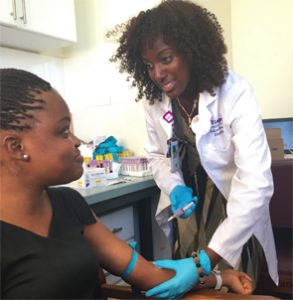Dr. Silverman, nationally recognized for his work on B cells and the immunopathogenesis in RA, lupus and a range of autoimmune and infectious disease, funded by NIH and the Rheumatology Research Foundation among other bodies, plays a prominent role in the Division’s seminars relating to the basic sciences and translational research. He also teaches medical students and graduate students on topics in the basic sciences and clinical medicine.
In addition to his clinical and translational research, Dr. Belmont’s role as an educator includes preparing fellows in the diagnosis and management of systemic connective tissue diseases, chiefly lupus, but also scleroderma, dermatomyositis and antiphospholipid syndrome. He also presents at the annual “research speed-dating session,” a special day when faculty members involved in translational research describe for fellows their ongoing projects. “It’s a chance for each of us to learn and get status reports on our faculty members’ laboratory findings and future directions,” he says.
Registry Advances Research
Dr. Buyon, who trained with Dr. Weissmann, and whose research focuses on bench to bedside studies in lupus and anti-Ro associated congenital heart block, assumed the position of Division Director in 2013 when Dr. Abramson became chair of the Department of Medicine. Her laboratory in the Medical Science Building of Tisch Hospital has become “action central” for the activities of the Division.

Ashira Blazer, MD, with a patient
at a clinic in Ghana, where she
researches SLE.
Establishment of the Division-wide patient registry, named the Specimen and Matched Phenotype Linked Evaluation, or SAMPLE, has boosted the mission to integrate patient care with basic science research, she says. A joint effort by members of the faculty and expanding upon studies previously initiated by Drs. Silverman, Scher and Abramson, the protocol was approved by the Institutional Review Board to use a uniform consent for collecting blood and tissue samples from all patients with autoimmune disease. The consent forms are written in English, Spanish and Mandarin, reflecting the population NYU serves. The biorepository linking clinical information and specimens is maintained by Robert Clancy, PhD, associate professor of medicine. “This has become a wonderful resource for NYU Langone,” says Dr. Silverman, who is spearheading research on the microbiome in lupus.
Dr. Belmont agrees. “By creating this bioregistry, we are in a position to very accurately describe specific subsets of patients with heterogeneous conditions such as SLE, and the biomarkers that allow identification of early disease and response to treatment. We are then in the best position for others at the bench [Drs. Silverman, Clancy, Mor and Nowatzky] to find the next opportunity for treatment.”


